Content refreshing is one of the best ways to increase traffic of your existing content, and it’s also a great way to keep the information on your website fresh and up to date.
However, the content refreshing process isn’t always straightforward. For example, some people worry about tanking their organic traffic if they update the content (a valid concern). Other people find that it just doesn’t bring the dramatic traffic increase that some marketing experts promise.
Fortunately for you, I’ve been both of those people.
I’ve updated probably more than 50 blog posts in the past 12 months, and I’ve made a lot of mistakes. However, I’ve also seen outstanding results, such as content that drives 10 times more traffic and soars in rankings.
That said, I really wanted to know why some posts perform dramatically better post-update than others.
So I did a data study on what makes some content dramatically more successful post-update and why others continue to flounder. Using this data, I’ve come up with a content refreshing strategy that has significantly improved my content refreshing success rate. Today, I want to share that strategy with you.
Contrary to popular belief, not all blog posts are worth updating. This is one of the single most impactful realizations that has improved my content refreshing success rate. In fact, I only recommend prioritizing updates for old content that earned 20+ monthly visitors at peak performance.
In the data study mentioned above, 45% of the updated posts had fewer than 20 visitors per month pre-update. Unfortunately, this 45% of updated posts only contributed 15% of the total traffic increase (of a 96% total organic traffic increase).
That means blog posts that already had 20+ monthly visitors before the update contributed the majority of the total organic traffic increase.
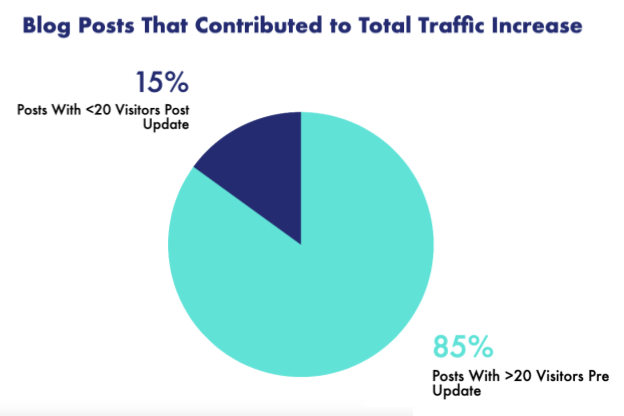
My guess is posts with more traffic pre-update already rank for some keywords in positions #5–10. Therefore, it’s much easier to go from positions #5–10 to first than zero to first.
So what should you do with blog posts that have fewer than 20 monthly visitors?
Assuming these posts are targeting keywords that are valuable to your business or contain important thought leadership ideas, it’s definitely worth updating them. In addition, a smaller blog will generally have a lot more blog posts with fewer than 20 monthly visitors simply because it needs time to gain traction.
Therefore, it’s still worthwhile to update them, but prioritize posts with the most potential first.
Once you know which posts to update, how do you actually update them? I’ve found that a lot of companies give freelance writers a process that looks like this:
- Update old statistics, facts, quotes
- Add additional paragraphs for keywords the posts are missing
- Remove sections that are no longer relevant
However, I’ve found that the above strategy isn’t the best approach to refreshing content. It makes the content more up to date but doesn’t consider how the post is (or is not) fulfilling the search intent.
In other words, you have to ask why your content isn’t as useful as the posts ranking well on Google. (I’m willing to bet it’s not just because there’s an outdated statistic in the third paragraph.)
From the content refreshing research I’ve done, your post probably isn’t ranking because there is another post that:
- Is more current.
- Provides actionable advice (or more relevant details).
- Offers an excellent user experience.
- Is a better fit for the searcher’s intent.
To address these issues, here are the action steps you need to take while updating your content.
1. Update outdated information
I know I just said that refreshing content is much more than just updating outdated information—but it is a part of the process.
In addition, I’m talking about more than just updating old statistics and quotes. Often, you’ll have to update (or completely change) the examples to improve how they match the search intent.
For example, this is one of my most successful content refreshing examples ever. It was generating about 4,000 monthly visitors when I first updated it in 2019. At its peak performance, it generated about 20,000 monthly visitors.
When I started updating it, I realized that most of the examples in the post were outdated and many were TV productions. This was a problem for two reasons:
- TV commercials themselves aren’t really a great fit for someone searching “digital marketing campaigns.”
- Most of the people Googling this term don’t have the budget for a TV campaign.
Therefore, I replaced all 31 examples with 31 new examples of recent SEO, content marketing, YouTube, and podcasting successes.

Sidenote.
In retrospect, I wish I had focused on a specific campaign rather than the brand’s entire strategy. This is as the searcher’s intent is a digital marketing campaign, not a digital marketing strategy. I bet the post would have performed even better if I had done that. But we’ll get into searcher intent a little later.
Key Takeaway
Is the information you provide up to date with the current trends in your industry? This includes not only quotes and statistics but also examples that you use.
2. Add actionable advice/cut irrelevant detail
How often have you read a post that vaguely describes what you should do and lacks examples or the action steps needed to execute the advice?
On the other hand, have you ever read a post that has the answer to your question somewhere in it? But then there is so much unnecessary information that you can’t find what you want.
Both are equally problematic and, unfortunately, common in content marketing.
First, let’s discuss posts that lack depth. Unfortunately, there is no specific metric you can check to see if the content has depth. Though, there are a few signals that can clue you in, including:
- Few to zero examples.
- A significantly shorter word count than what’s ranking.
- Generic tips with no actionable information.
You can also use content optimization tools like Clearscope, which shows the subheadings that commonly appear in other top-ranking posts. While I recommend that you take these keyword tools with a grain of salt (don’t try to sprinkle in all of the keywords), they can help you uncover topics you may have overlooked.
For example, if you’re writing a guide to “medical SEO,” the tool may show that the word “backlinking” is commonly used in other posts. Given that backlinking is a key element of SEO, this is a helpful insight because you’ll definitely want to create a section on that topic.
Beyond this, the best advice I can give you is to put yourself in your target audience’s shoes (ideally, you’ve already done extensive market research and talked to several customers).
Ask yourself: If they read this content, could they implement the advice given and see results?
To drive this home, let’s look at an example where the post lacked depth. This post, “13 Ways to Market Your Business Online,” is the very first post I ever updated. It was originally just 930 words long and drove between 30 and 50 monthly visits. The final product is 1,700 words. It now drives over 600 monthly visits.
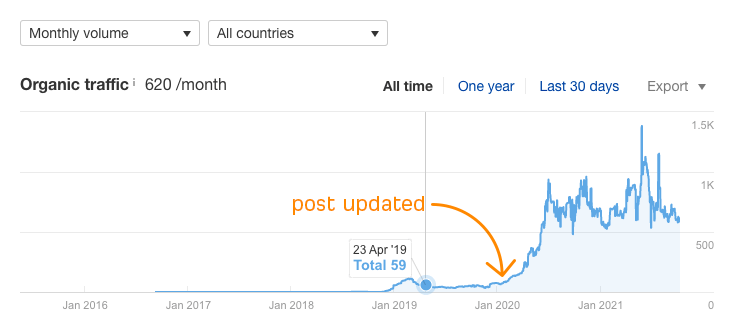
However, I didn’t just decide to make it longer to accomplish this. Instead, I added relevant, actionable advice to support my argument.
For example, in the excerpt below, you can see that I supported my argument (building a brand is important) with a quote from Google CEO Eric Schmidt. I also added an actionable tip to make the tip less vague.
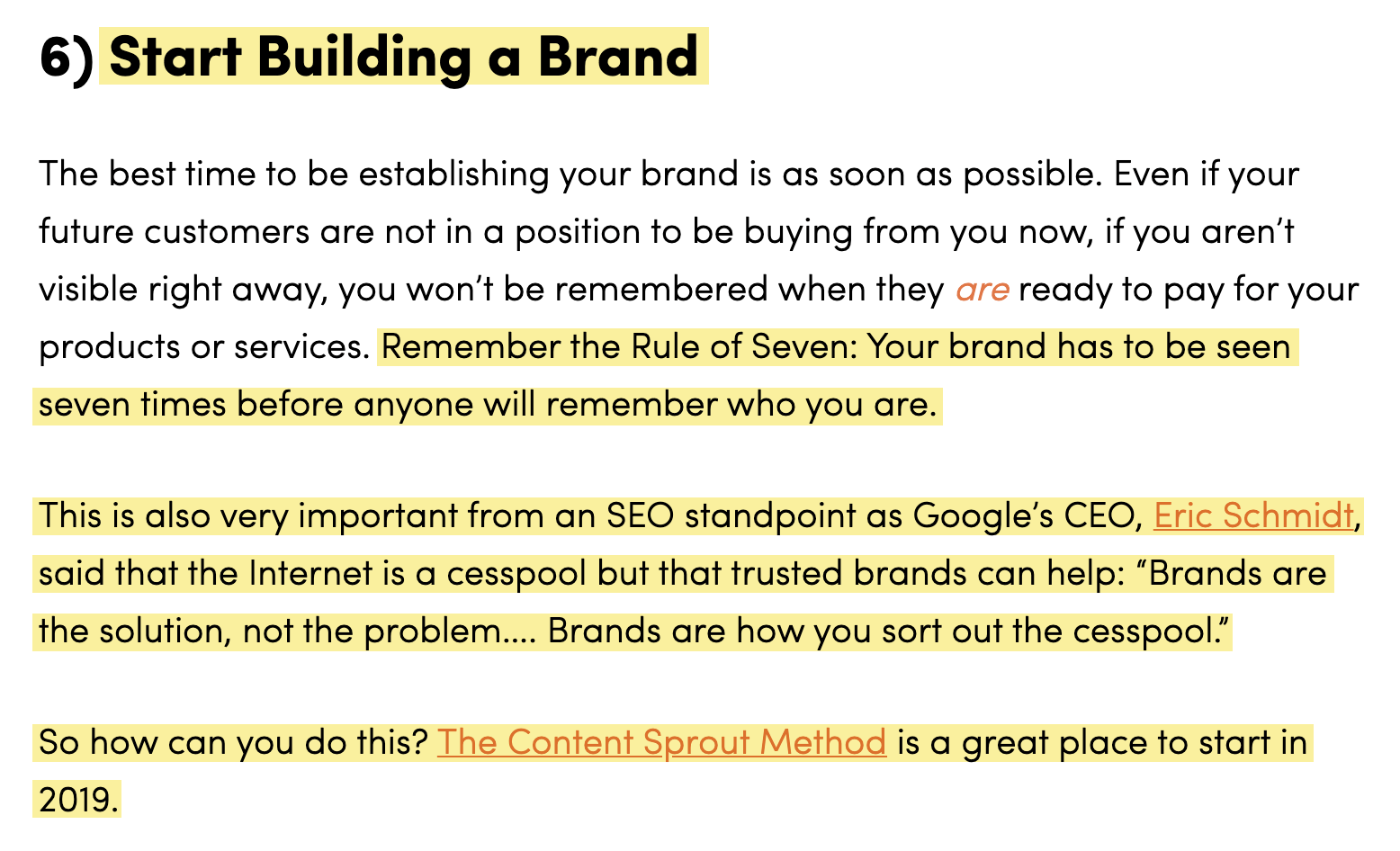
Everything highlighted was added or changed when updating the post.
That said, adding more depth isn’t always the best solution, as it can make content unnecessarily long-winded.
For example, let’s say you’re writing a post on “how to change a tire.” In this case, the reader really doesn’t want a 2,000-word guide—they just want to change their tire as quickly as possible!
So instead of writing about the mechanics of changing a tire and statistics on how many people know how to change tires, just give the reader the steps they need to change the tire.
While that may be a rather obvious case, I see this all the time when I update content (especially if it’s an ultimate guide). For example, here’s the table of contents of a post I’m preparing to update:
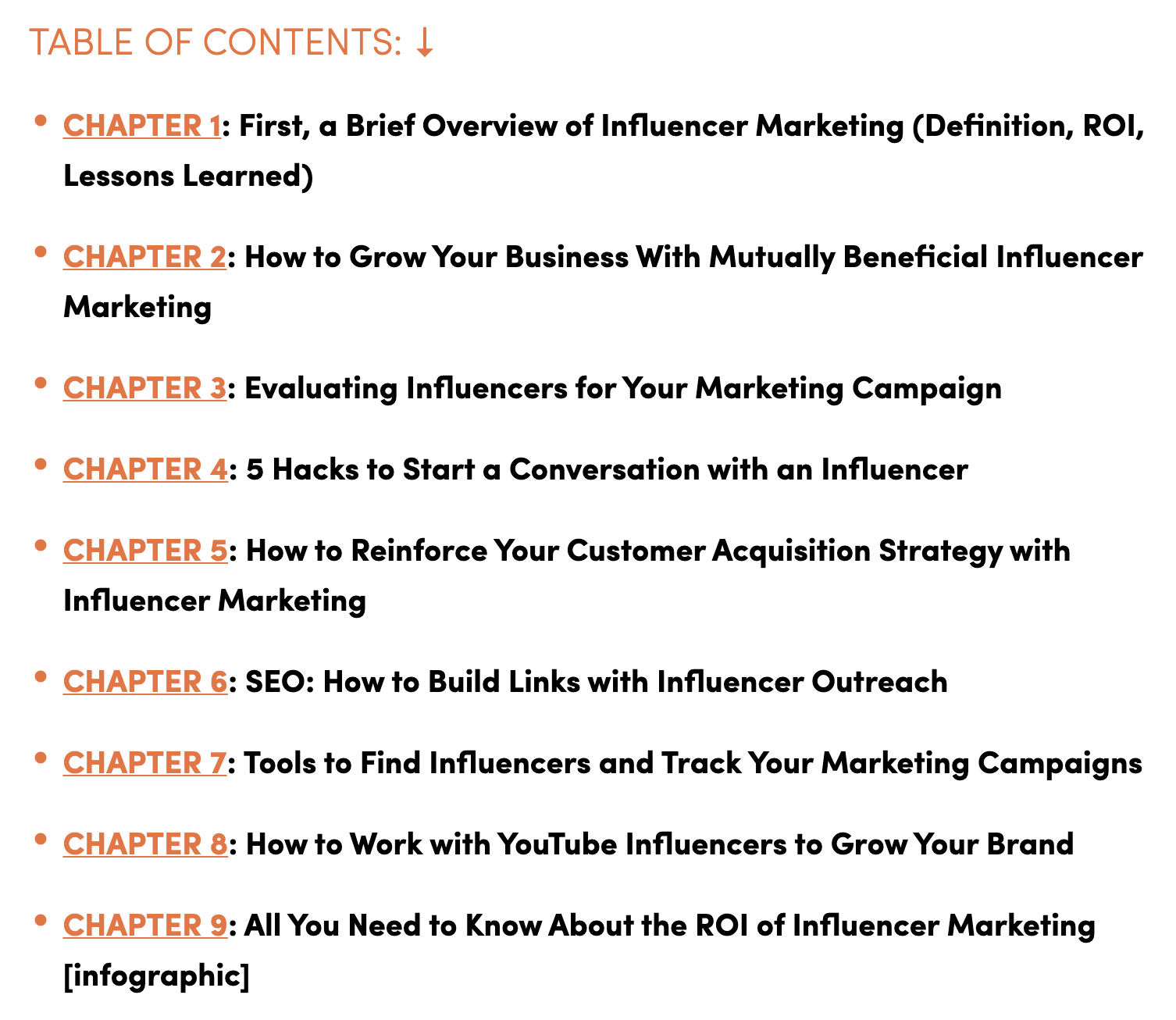
As you can see, the content is too long and repetitive. For one, it talks about the ROI of influencer marketing twice. Sure, it’s an ultimate guide. But even those reading an ultimate guide only want to consume the necessities to get them on their way.
Another example of how this content is too long-winded is in chapters 2 and 7, where both discuss tactics on reaching out to an influencer. Sure, they discuss slightly different tactics. But I’d rather read one concise section on the 80/20 of influencer outreach than several sections containing every possible way you could reach out to an influencer.
Key Takeaway
When you’re writing, include the 80/20 action steps your reader needs to know, along with examples (hypothetical or real) to prove your point. However, don’t write any more than that. The reader doesn’t necessarily need to know every single possible way to do something or the exact science behind every topic. Get to the point.
3. Improve the user experience
Google has always stressed the importance of optimizing for user experience. Much of this takes place at the site level (HTTPS, page speed, etc.). But there are things you can do to improve content on a post-by-post basis.
First, if your post is particularly long, consider adding a sticky table of contents to help the reader find exactly what they are looking for.
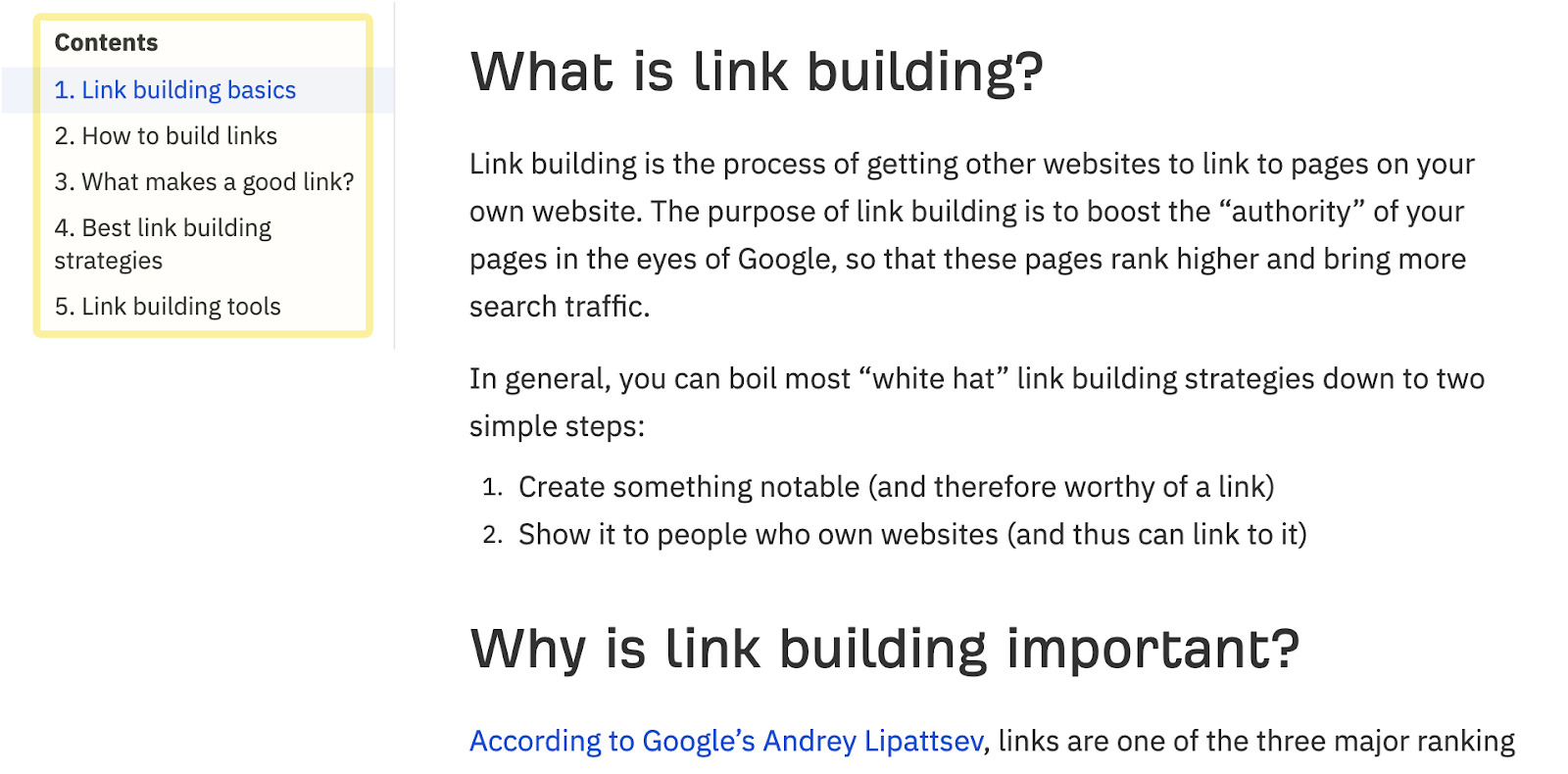
Second, pay a designer to create attractive, branded graphics. This will go a long way in both keeping users on your page and establishing your blog as an authority.
Third, break up your paragraphs (ideally none longer than three to four sentences) and use bullets to keep the reader’s attention. Remember that most people are looking for fast answers and are, therefore, skimming. So contrary to popular belief, making your content skimmable will actually increase the time readers spend on your page.
As simple as these things may sound, they’re super effective in my experience.
Key Takeaway
Don’t discount the importance of a blog post that is clean and easy to read. Sometimes, long blog posts are too frustrating for users, so be sure to format your blog posts appropriately and hire a designer to help you.
4. Fulfill the searcher’s intent
Search intent is basically the reason behind the search. Does the searcher want to learn something or buy something? Are they looking for a detailed guide or skimmable listicle? Do they just want a quick answer or lots of knowledge?
If you fail to understand the answers to these questions, you’ll be at risk of misaligning your content with search intent. Consequently, it’ll be much harder (sometimes impossible) to rank the content.
This is quite a complex topic, as there are many ways you may misalign content with search intent. But here are three of the main ways I’ve noticed:
A. Post style is incorrect
Before you write your blog post, Google the main keyword to better understand what kind of blog post the reader wants.
For example, if you’re about to write a how-to guide for a term like “best CRM for small businesses,” you’re wasting your time because the searcher’s intent is clearly a simple list of tools:
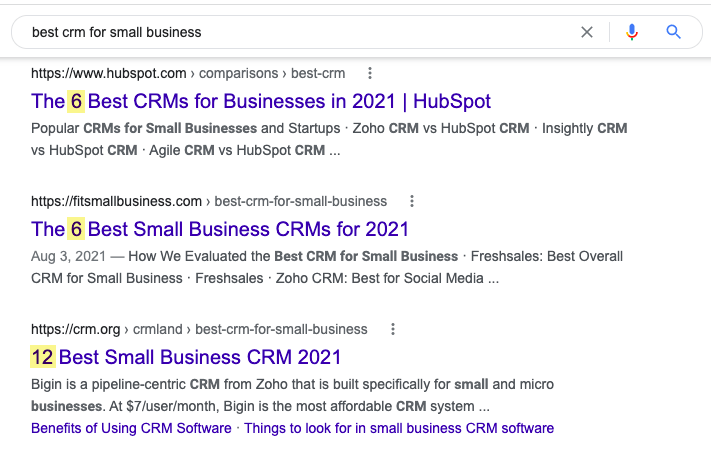
In this case, they don’t want to read a guide about it. They just want to see some solutions!
If you notice that your blog post is in the wrong format for that keyword, you’ll probably have to rewrite it altogether.
B. You have too much information irrelevant to the reader’s pain points
Another issue I often find when updating content is there are sections of content that just aren’t relevant to the reader’s pain points.
For example, a post on “content marketing KPIs” shouldn’t have a header with the words “what is content marketing.”
While that’s a rather extreme example, I often see subtler cases.
For example, I recently updated a post targeting the keyword “examples of storytelling marketing.” When I looked at the search results for the term, all of them were list posts that had introductions around 100–200 words. The post then dove into examples.
However, when I looked at the post I was updating, there were several sections before the “examples” section that totaled 1,800 words. In fact, here is what the post’s structure looked like:
- What is storytelling?
- Science behind storytelling
- Why is storytelling important for marketing?
- Five principles of storytelling
- Principle 1
- Principle 2
- Principle 3
- Principle 4
- Principle 5
- (Finally!) Example 1
In this case, the searcher’s intent is a list of examples. So if the searcher has to scroll past 1,800 words to read what they want, they’ll likely leave. This behavior is a signal to Google that your content isn’t very good.
To update it, I cut that intro and added a few extra relevant examples (most of the other posts had 11–12, so I made the post fit that range). As of this writing (a few weeks after my updates), the post is ranking second for “examples of storytelling marketing.”
Here’s a screenshot of its traffic trajectory:
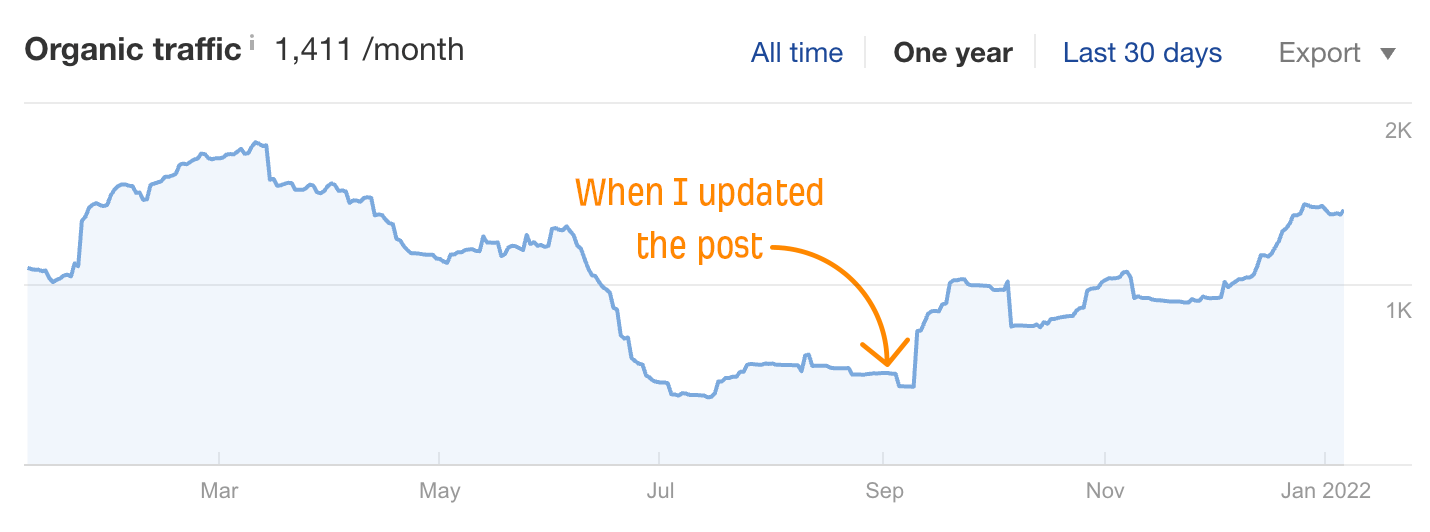
C. You aren’t speaking at the reader’s knowledge level
Finally, there are plenty of blog posts that miss the search intent because they speak above or below the reader’s knowledge level. Hence, they’re deaf to the reader’s pain points and desires.
Let’s walk through an example.
Imagine you are selling a SaaS marketing tool to content marketing managers, and the keyword you’re targeting is “content marketing KPIs.”
Here’s an example of an introduction that is below their level:
Content marketing is a great way to increase your traffic and generate more leads for your business. In fact, anyone that performs a Google search is looking for blogs like yours to provide the answer to their questions. However, some content is more effective than others. Therefore, to make sure that your content is on track, you need to measure KPIs (key performance indicators).
This is inappropriate for two reasons:
- Content managers already understand the value of content marketing, so explaining that is redundant.
- Given that they are searching for KPIs, there’s no need to explain why they need KPIs. They were already convinced before they landed on your post.
In contrast, here’s a much better introduction for the very same keyword and scenario:
Tracking the performance of content marketing campaigns is tricky as the ROI often takes months or even years to realize. Therefore, most people measure their content strategy’s success by the traffic it’s generating.
While traffic can correlate with better business results, this isn’t always the case. For example, you may be driving traffic that isn’t ready to buy or from a parallel industry.
Therefore, traffic shouldn’t be your only measure of success. Instead, this post will detail which KPIs you should measure to ensure your content is driving an ROI and how to track them.
Notice the introduction above also speaks to a more experienced audience (content marketing managers). It touches on their pain points and relates to how they are (most likely) already tracking content marketing. Now, it’s probable they’ll keep reading.
However, the issue of speaking above or below an audience’s level doesn’t just apply to introductions. As you’re updating the content, ask yourself if each paragraph resonates with the audience’s pain points.
Recommended reading: Searcher Intent: The Overlooked ‘Ranking Factor’ You Should Be Optimizing For
Key Takeaway
First, Google your keyword before you start writing to make sure you are using the right blog post structure (how-to, listicle, etc.). Then ask yourself if each section within the post is relevant to the searcher’s pain points. Finally, ask yourself if the writing is at the searcher’s knowledge level.
5. Make final optimizations
Now that you’ve done the hard part of actually updating the blog post, make sure that you do these last few optimizations, as they can mean the difference between a 2X and 10X ROI.
First, take a look at your average click-through rate (CTR) in Google Search Console. According to a study done by Databox, a good organic CTR is 3%-5%. Therefore, if your post isn’t hitting that benchmark, consider updating your title tag and meta description.
If you really want to improve your organic CTR, you can also use a tool like ClickFlow to run A/B tests on your title tags and meta descriptions.
Another easy way to improve your refreshed content’s performance is by building internal links to it from other posts that are relevant and powerful (have plenty of external links from high-quality sources).
If you have the resources, building external links to your refreshed content is also a great strategy. While most outreach tactics are overused, here’s one to consider: offering to update the content for the people whom you’re reaching out to (instead of just offering a guest post).
Here’s an exact pitch I’ve used before with success:
Hi Sam,
I read your post about the best marketing agency tools for 2022 and just signed up for [Service] based on the post. So thanks for the rec!
However, I noticed that some of the recommendations are a little dated.
For example, you recommend [Tool A], but I’ve found that there are now cheaper tools like [Tool B] and [Tool C], which do essentially the same thing.
I also think that if you had 10 tools rather than 5 tools, the post might rank higher. Would you like me to update it for you for free? I’d also love to include a (non-promotional) section on our analytics tool, which a lot of agencies use.
If you don’t love my new version, no pressure to post it.
Thanks,
Megan
You don’t have to use this exact template. But hopefully, this can get you started. If you have examples of posts you’ve updated that later performed better, you may want to include that somewhere in the pitch.
Key Takeaway
Once you’ve updated your post, the last few optimizations include improving your title tag and meta description to drive more clicks, adding a few relevant internal links to the post, and building some external links to the post (if you have the resources).
Final thoughts
Content refreshing is still an underused tactic that a lot of blogs can benefit from. If you tried it before and it didn’t work, there could be another underlying issue, e.g., a poor user experience, an irrelevant section in the beginning, or a poor search intent match.
At the end of the day, not every blog post will perform better. Sometimes, search engines just don’t approve of certain posts. But if you make refreshing content a priority, follow the steps above, and add the updated content to your editorial calendar, you’ll have some posts that’ll take off post-update. This more than makes up for all of the time invested in posts that didn’t succeed.
Got questions? Ping me on Twitter.
